"...the most skeptical scrutiny of all hypotheses that are served up to us, and at the same time, a great openness to new ideas. Obviously, those two modes of thought are in some tension."
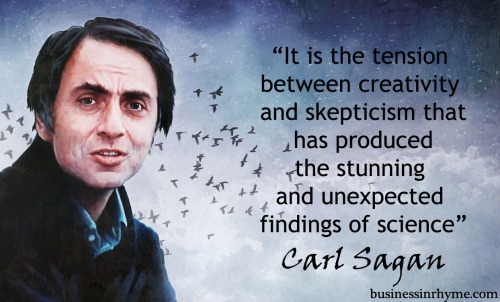
Sagan believed that exercising only one of these modes won't be good for anyone. When your default settings are to be immediately distrustful of strangers and to be skeptical of what you see on TV, hear on the radio, or read in the papers every day, you'll surely find it hard to travel alone - meeting new people and making new friends along the way - and to let your hair down a bit to appreciate the sights, food and drinks, and local festivities.
While skeptics and unbelievers occupy one end of the belief spectrum, people who firmly believe in the healing power of crystals after they've been exposed to the silver light of a full moon at its zenith probably need a healthy dose of disbelief, now and then. Crystals either absorb or refract light, and allow the transference of either heat or cold energy, but that's all they can do. As inanimate objects, they don't have mystical powers to take away your physical and emotional pain, help you find true love, or give you the material abundance that you seek.
It's amazing how much faith and trust some people are willing to invest on certain beliefs, sometimes to the point of gullibility and self-destruction. People who don't have an ounce of skepticism in them are easily fooled by hoaxes and rumors. As long as the information was shared by someone they knew or the source was a trusted entity, people who lacked critical thinking skills would rarely question the validity of what they heard, saw or read.
As Sagan said, "If all ideas have equal validity then you are lost, because then, it seems to me, no ideas have any validity at all. Some ideas are better than others. The machinery for distinguishing them is an essential tool in dealing with the world and especially in dealing with the future. And, it is precisely the mix of these two modes of thought that is central to the success of science."
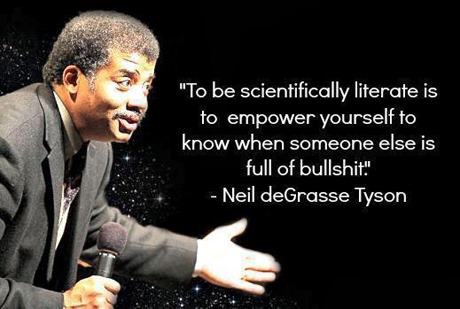
The Fine Art of Baloney Detection by Carl Sagan
Carl Sagan defines a "baloney detection kit" as a "set of cognitive tools and techniques that fortify the mind against penetration by falsehoods." It may be a set of questions that promote critical thinking, or a to-do list that you must complete, such as tasks you must do to fact-check the research article or press release you're reading.
Sagan's baloney detection kit has 9 invaluable tools of healthy skepticism that may be applied to everyday problems or situations.
- Wherever possible there must be independent confirmation of the "facts."
- Encourage substantive debate on the evidence by knowledgeable proponents of all points of view.
- Arguments from authority carry little weight — "authorities" have made mistakes in the past. They will do so again in the future. Perhaps, a better way to say it is that in science there are no authorities; at most, there are experts.
- Spin more than one hypothesis. If there's something to be explained, think of all the different ways in which it could be explained. Then think of tests by which you might systematically disprove each of the alternatives. What survives, the hypothesis that resists disproof in this Darwinian selection among "multiple working hypotheses," has a much better chance of being the right answer than if you had simply run with the first idea that caught your fancy.
- Try not to get overly attached to a hypothesis just because it's yours. It's only a way station in the pursuit of knowledge. Ask yourself why you like the idea. Compare it fairly with the alternatives. See if you can find reasons for rejecting it. If you don't, others will.
- Quantify. If whatever it is you're explaining has some measure, some numerical quantity attached to it, you'll be much better able to discriminate among competing hypotheses. What is vague and qualitative is open to many explanations. Of course, there are truths to be sought in the many qualitative issues we are obliged to confront, but finding them is more challenging.
- If there's a chain of argument, every link in the chain must work (including the premise) — not just most of them.
- Occam's Razor. This convenient rule-of-thumb urges us when faced with two hypotheses that explain the data equally well to choose the simpler.
- Always ask whether the hypothesis can be, at least in principle, falsified. Propositions that are untestable, unfalsifiable are not worth much. Consider the grand idea that our Universe and everything in it is just an elementary particle — an electron, say — in a much bigger Cosmos. But if we can never acquire information from outside our Universe, is not the idea incapable of disproof? You must be able to check assertions out. Inveterate skeptics must be given the chance to follow your reasoning, to duplicate your experiments and see if they get the same result.
CASE IN POINT: The Baptist University Study
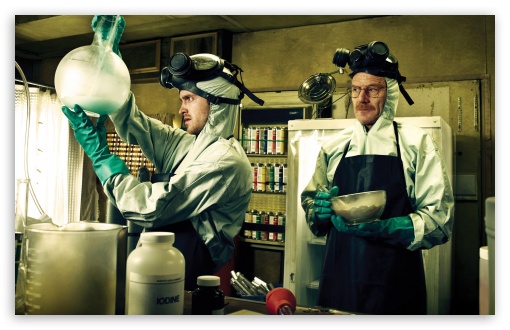
Walter White and Jessie showed more respect for science in Breaking Bad than the researchers from Baptist University in Hong Kong.
Particular emphases were given to some of the phrases and sentences in the above list. These are the glaring mistakes that anti-vaping researchers generally make. In spite of their rigid training in the scientific and medical research field, these lowly paid academics produced generally inconclusive results from an unimpressive body of vaping-related research.
Sagan's baloney detection tips worked pretty well in highlighting the inconsistencies of the Baptist University study that was commissioned by The Hong Kong Council on Smoking and Health. There's obvious lack of independent confirmation of the facts that the research team revealed.
So far, only their team was able to identify the presence of a flame retardant chemical in e-cigarettes. It seems the Chinese manufacturers of the e-cigs in their sample used plastic internal parts that needed to be protected from the intense heat produced by the atomizer.
Outside of Hong Kong and China, however, stringent regulations in maintaining product quality and functionality require that vaporizers are generally constructed out of heat-resistant glass and metal parts. Inadvertent exposures to thermoplastic chemicals were easily prevented by using BPA-free heat-resistant materials.
The researchers from Baptist University claimed that the e-cigarettes they tested produced vapor that's more toxic than the polluted roadside air of Hong Kong.
"[Level of PAHs] in e-cigarettes is at least one million times more than roadside air in Hong Kong," said Dr. Chung Shan-shan, an assistant professor in the university’s biology department.
What the biology professor didn't mention, however, was that polycylic aromatic hydrocarbons (PAHs) were normally the by-products of an incomplete combustion of organic materials, such as wood and coal. That means, the researchers applied too much power to the atomizer and exposed the internal parts of the e-cigs to extraordinarily high heat that they got BURNED, which would never happen to someone who's vaping in a normal way. Otherwise, the vaper would surely have blisters and minor burns in his mouth and throat.
Based on their findings, the researchers from Baptist University did a great job in exposing the bad business practices of Hong Kong's and China's e-cigarette companies. These manufacturers ignored the toxicity and hormone-disrupting effects of polybrominated diphenyl ethers (PBDEs), the flame retardant chemical they sprayed all over their products. Moreover, these companies couldn't be trusted to show some transparency by revealing the exact amounts of nicotine and other liquid ingredients on the labels of their products.
Baloney Detection Kit by Michael Shermer
Welcome to the first educational video that was presented by The Richard Dawkins Foundation for Reason and Science! In this short clip, Dr. Michael Shermer - who is the publisher of Skeptic Magazine - lays out these 10 important questions to ask when trying to discern the truth from the lies being broadcasted in the news and other mainstream media.
CREDITS
This is the first video by RDFTV.
Presented by The Richard Dawkins Foundation for Reason and Science
Directed by Josh Timonen
Produced by Maureen Norton
Animation by Pew 36 Animation Studios
Music by Neal Acree
Post Production Sound by Sound Satisfaction
Supervising Sound Editor/Re-Recording Mixer: Gary J. Coppola, C.A.S.
Sound Editor: Ben Rauscher
Production Assistant: Graham Immel
Copyright © 2009 Upper Branch Productions, Inc.
THE TEN QUESTIONS
- How reliable is the source of the claim?
- Does the source make similar claims?
- Have the claims been verified by somebody else?
- Does this fit with the way the world works?
- Has anyone tried to disprove the claim?
- Where does the preponderance of evidence point?
- Is the claimant playing by the rules of science?
- Is the claimant providing positive evidence?
- Does the new theory account for as many phenomena as the old theory?
- Are personal beliefs driving the claim?
How Personal Beliefs Drive Anti-Vaping Claims
Sponsors and researchers who wanted to find incontrovertible proof that e-cigs are worse than cigarettes probably get their motivation from their personal beliefs. The peer-reviewed studies and anecdotal evidence on the multiple benefits of vaping won't even matter to them. Their savage propaganda-fueled attacks on smoking and vaping reveal them as fanatics.
In his blog post titled "Sacrificial Lambs," Brainy Fur Ball called them violent zealots because they were practically pushing many vapers to give up their e-cigs and return to smoking, which they stubbornly believe to be as harmful as vaping. They didn't care about tobacco's toxic chemicals and that they're putting hundreds of human lives at risk by pushing for a total e-cig ban. They've elevated their anti-smoking and anti-vaping beliefs into dogma and turned their socio-political crusade into a fight to preserve public morals and social ethics.
Check out the following statements of two anti-vaping ZEALOTS who believed that scientific research would have little to no effect on legislation:
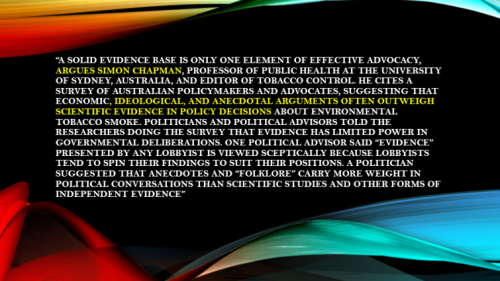

A Rough Guide to Spotting Bad Science
These three lovely infographics tell a simple story. Before looking into what makes bad science bad, find out the different types of scientific results that researchers want.
Anecdotal and Expert Opinions are common sources of reliable information in the vaping world. In e-cigarette and vaping research, case-control and cohort studies on selected test subjects are the preferred methodologies.
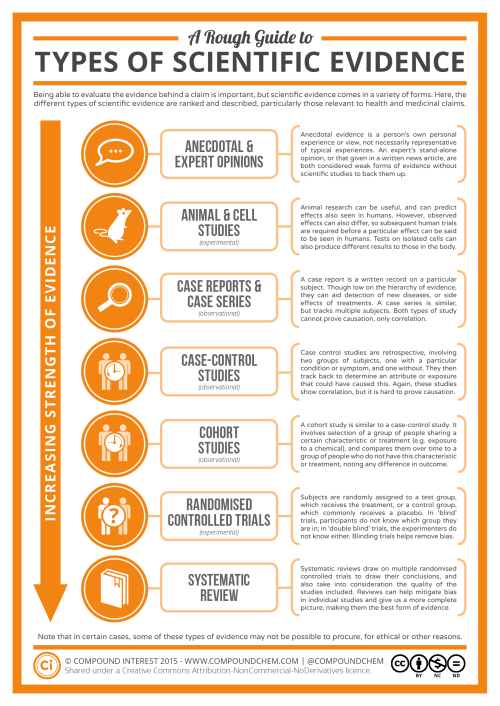
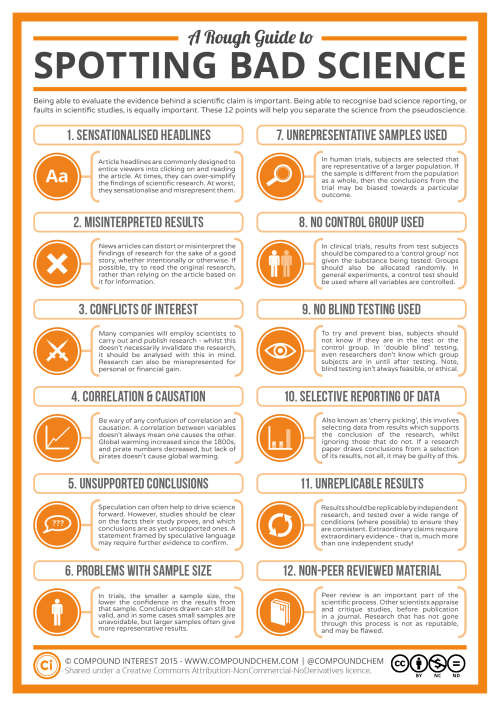
Both of these beautiful infographics are available for free from the Compound Chem website. The misbehaving scientists and doctors this week refocused the spotlight on 'bad science' and the different types of scientific misconduct among researchers. When these kinds of behavior are discovered, researchers are forced to retract their work from the scientific journal or university archives.
Unfortunately, most of the research done on vaping and e-cigarettes were commissioned by tobacco firms and anti-smoking advocates. It's not surprising for the results of those studies to fit the expectations of the people who paid for them.
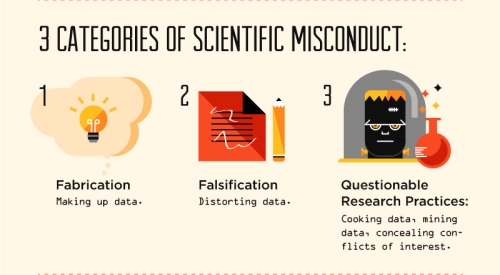
The above image is spliced from a cool infographic made by creative folks at Clinical Psychology. A complete copy of this infographic has been published at Watts Up With That along with the links to the source of data. You may want to read this interesting blog post on scientific fraud.
The Stinkiest Baloney of Them All: Anti-Vaping Advocates Would Rather See You Smoke and Die Than Lose Out to E-cigarette Companies
People who left behind their cigarette smoking days to take up vaping as a smoking cessation method are as brave and adventurous as New Age practitioners. They're leaving behind a familiar activity (smoking tobacco) for something that's an entirely different experience.The long-term effects of vaping are largely unknown, and its short-term effects are often misunderstood by the majority.
That's why, vapers are widely perceived as "misguided" nicotine addicts by their detractors.
These anti-vaping groups and individuals are vehemently opposed to the current unregulated use of electronic cigarettes and advanced vaporizers by adults who used to smoke because they're not entirely convinced that e-cigs don't pose a threat to public health. Yet, they're not too worried that they've been scaremongering people into going back to using filtered lights or menthol smokes.
And, that's not the worst thing they could have done to people who vape. They're anxious to strip the vaping industry of the commercial freedom and legal capacity to further develop the hardware and software technologies of the current crop of personal vaporizers.
Nicotine delivery devices are just the tip of the vaping tech iceberg. Doctors acknowledge the potential for vaporizer development for therapeutic use. For starters, new vaporizers can be made for asthma sufferers. Research and development can later focus on developing advanced vaporizing systems for the quick and painless delivery of prescription drugs to the patient's bloodstream and internal organs via inhalation.
Now, imagine cutting off these potential developments at the bud and stunting the growth of the vaping industry. In keeping the status quo, anti-vaping groups make sure smokers around the world continue to patronize Big Tobacco products. And, they'll never be given the chance to reduce their health risks of developing a respiratory disease or a smoking-related cancer in the future. Their choices are limited to inhaling nicotine-filled smoke from a burning tobacco cigarette and chewing flavored tobacco until they have a permanent reddish tint on their gums and tongue.
It's a very informative post,.
ReplyDeleteVape in Dubai
Thanks for sharing this nice and informative post,
ReplyDeleteE-Liquid Shop UK
If you would like an alternative to casually approaching girls and trying to find out the right thing to say...
ReplyDeleteIf you'd rather have women chase YOU, instead of spending your nights prowling around in filthy bars and night clubs...
Then I urge you to play this eye-opening video to unveil a strange little secret that has the potential to get you your own harem of attractive women just 24 hours from now:
Facebook Seduction System...